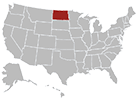
Those located in North Dakota who are interested in becoming sterile processing technicians (SPTs) will need to know the steps to take to become one.
An SPT is a vital part of the hospital, as they help clean and disinfect medical equipment.
Not only that but by doing so, they can help prep equipment and ensure patient safety.
It’s a fulfilling job but requires a lot of learning and expertise.
Steps to Become a Sterile Processing Technician in North Dakota
North Dakota allows those who want to become an SPT a few options to become one.
First, those interested can attend an accredited certificate program.
Secondly, they may also receive on-the-job training or learn through a related program.
It’s important to understand the qualifications and steps you’ll need to take, which are listed down below.
Step 1: Meet Minimum Requirements
Similar to many other jobs, an SPT needs to meet certain requirements such as being at least 18 years old.
This is a set requirement due to the demands of the job.
An SPT is in charge of disinfecting equipment, and if done improperly, it could harm patients.
Hence, SPT jobs will want to hire those who are at least 18 years old.
In addition to that, employers will also want their SPTs to have a high school diploma or equivalent.
For example, a GED can suffice if they do not have a high school diploma.
That said, educational requirements are required by most jobs and certificate programs.
Step 2: Attend an Accredited SPT Program
Future SPTs who can’t find an entry-level position should opt to get certified.
Employers will look for applicants who either have prior experience or have the educational equivalent.
The reason for this is that they want to ensure that those they hire are properly trained and know what they are doing.
Those opting to take a certificate program will need to ensure that they are accredited.
Two credentials are accepted, which are the Certification Board for Sterile Processing and Distribution (CBSPD) and the International Association of Healthcare Central Service Material Management (IAHCSMM).
Programs that aren’t accredited aren’t an acceptable form of training.
Step 3: Pursue a Similar Certificate
This is an optional step, but those who can’t find an SPT certificate program or entry-level jobs can also pursue similar certificate programs.
Two identical programs to an SPT are the Certified Registered Central Service Technician (CRCST) and the Certified Sterile Processing and Distribution Technician (CSPDT).
These alternative programs cover similar subjects and are nearly identical in terms of training.
However, these alternative programs may also cover additional topics that may not be found in the A Sterile Processing Technician certificate program.
So, these extra programs can help show future employers that you have learned the necessary skills to complete the job.
Step 4: Get Hands-On Experience
For those who want to become a sterile processing technician, it’s important to get hands-on experience.
The normal way most sterile Processing technicians get experience is by being hired in an entry-level position.
However, those who can’t find an entry-level position often find themselves applying for internships or volunteer positions.
Step 5: Apply
Once you’ve either completed training, an entry-level job, or have completed a certificate program, you can then apply.
If you’re finding it difficult to find sterile processing technician job openings, then you may want to try using recruitment boards or networking.
One of the better ways to find job openings is by networking with other healthcare professionals.
Contacting clinics and letting them know your availability can also be a good way to get your foot in the door.
Licensing Requirements to Become
North Dakota is one of the many states that doesn’t require Sterile Processing technicians to hold a certificate.
That is why many applicants will find entry-level jobs listed on job boards.
However, those with an accredited certificate will be more likely to be hired by employers.
To help give your resume a boost, completing an accredited certificate program or related certificate program may be necessary.
Salary
A sterile processing technician in North Dakota makes an average salary of $39,244.
On the low end, SPT will make $31,314.
However, those with more experience and education can make upward of $48,776.
The salary changes mainly based on location, education, and experience.
For example, those living in a large city compared to a remote area generally make more to match the cost of living.
Annual Salary Range:Average Salary of Sterile Processing Technicians in North Dakota
| City Name | Salary |
|---|---|
| Beach | $38,808 |
| Burlington | $38,808 |
| Buffalo | $37,460 |
| Columbus | $38,808 |
| Fairdale | $36,667 |
| Ellendale | $37,460 |
| Galesburg | $37,302 |
| Hope | $37,064 |
| Leeds | $37,738 |
| Minot | $38,808 |
Regional Salary
| Region | Employed | Avg. Annual Salary | Avg. Hourly Pay | Top 10% Annual Salary | Bottom 10% Annual Salary |
|---|---|---|---|---|---|
| Bismarck, ND | 50 | $45,520 | $21.89 | $56,830 | $34,060 |
| Fargo, ND-MN | 100 | $41,580 | $19.99 | $54,980 | $34,320 |
* Employment conditions in your area may vary.
Frequently Asked Questions
How long does it take to become a sterile processing technician in North Dakota?
The time it takes to become a sterile processing technician in the state of North Dakota will depend on what method one uses to become certified or acquire training.
Those who choose to attend a sterile processing technician program can expect it to take anywhere from 6 months to a year.
However, those who are applying for an entry-level position may be trained in as little as a few weeks.
Lastly, those who decide to take a related certificate program or even a diploma program may need to attend more schooling, which may take longer.
What is the job outlook for sterile processing technicians in North Dakota?
The projected outlook for SPTs nationally is estimated to grow by 6% over the next ten years.
This is notably higher than most careers, as they are often less than 3%.
This is mainly due to the future need for more surgical procedures and medical facilities.
What are the alternative programs for becoming a Sterile Processing Technician in North Dakota?
Becoming a Certified Registered Central Service Technician (CRCST) or a Certified Sterile Processing and Distribution Technician (CSPDT) can also be used to work as a sterile processing technician.
In addition, applicants may also attend a trainee position while working on the job.
That said, most sterile processing technicians end up in entry-level positions with on-the-job training in North Dakota.
Is a Sterile Processing Technician Certificate worth it in North Dakota?
Becoming a sterile processing technician is often a good career choice.
While completing a certificate program may not be necessary, it will give you more skills to be able to move up in the field.
Those with advanced knowledge who accumulate years in the field will end up being able to work with more expertise and higher pay.
What are the typical work hours and shifts for sterile processing technicians in North Dakota?
Anyone interested in becoming a sterile processing technician should know that the standard 40-hour work week is generally the minimum.
However, many hospitals may need you to be on call, which can easily add to those hours.
That said, those who do end up working more than the standard 40-hour shifts per week will end up making overtime pay.
Those who are also planning to become Sterile Processing technicians should also expect some shifts to last up to 12 hours.
This page is also available in Spanish.





